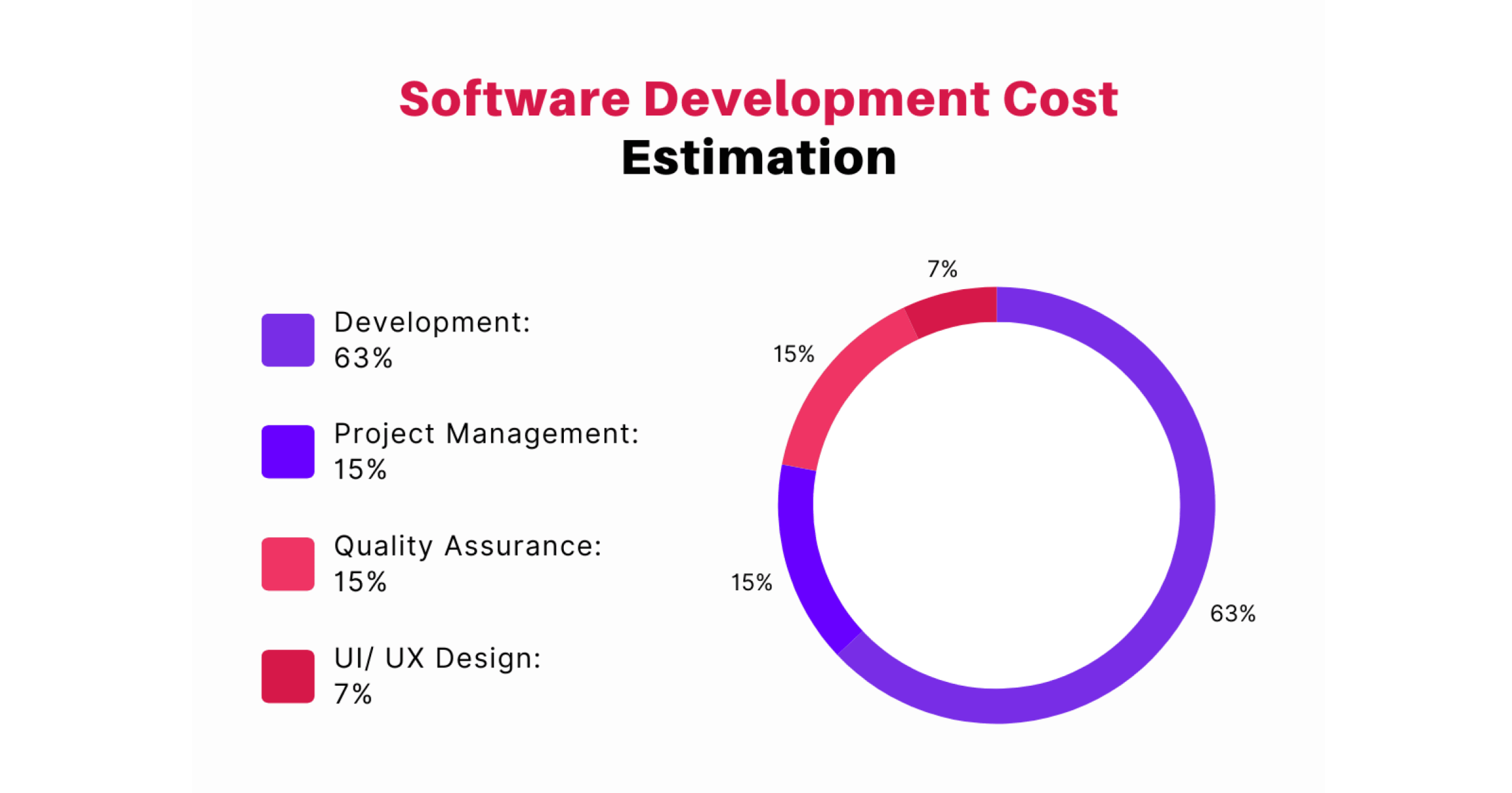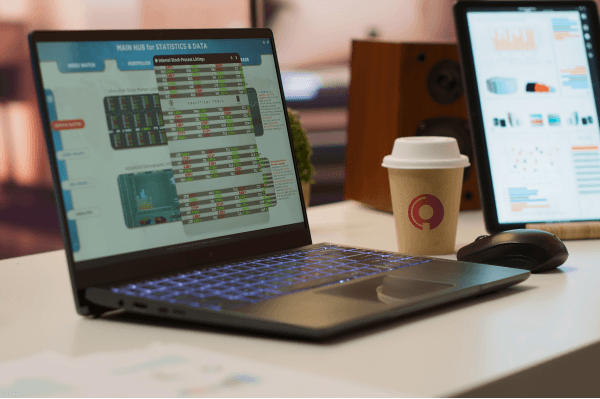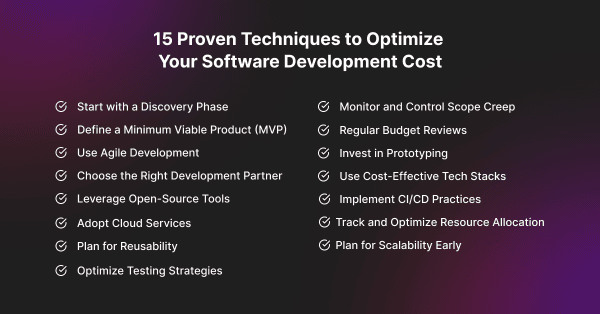How to Prevent Budget Escalation by Cutting Custom Software Development Cost ?
Dec 20, 2024
Building custom software for an Enterprise level Company? That is exciting! But let’s face it—keeping the budget in check can be a challenge. In order for our budget not to escalate, we need to have a good plan prepared.
The path from idea to development is full of ups and downs; hidden complexities pop up, project scope expands, and business needs shift along the way. When costs begin to rise, it is easy to lose sight of your original goals and end up with an unexpected hit to the budget.
In this guide, we will cover the reasons budget escalation happens and share practical strategies to keep costs under control, from early-stage planning to deployment. With the right approach, you will keep custom software development cost under control and see your project deliver real value.
Understanding Custom Software Development Cost for Enterprise Companies

Taking on a big software project? For large companies, building software is a serious investment, and managing costs from the start can save a lot of headaches down the road. This is not just about creating an app or a system that works — it is about building something that fits smoothly with everything else your business relies on, meets your goals, and can evolve as your business grows.
The process of software project cost management usually unfolds in stages: planning, design, development, testing, and ongoing maintenance. Each phase comes with its own requirements, from team expertise to technical tools, and the custom software development cost can quickly add up if you are not well-prepared. But understanding where the money goes at each step can help you keep things on track, avoid surprises, and make sure your budget supports both quick wins and long-term goals.

Discovery and Planning (10–15%)
This is the foundation, where the project’s scope, goals, and timeline are clearly defined. Investing time here minimizes surprises later. Expect to allocate 10–15% of the budget for project managers and business analysts to create a robust project blueprint.
Design (10–15%)
Design typically accounts for another 10–15% of the total budget, depending on the complexity of the software. This phase often involves graphic designers, UX/UI experts, and front-end developers.
Development (40–50%)
This is where the core of the software is built, making it the most resource-intensive phase. Typically 40–50% of the budget, this stage involves coding, integrations, and creating functionality. Regular feedback cycles during development help manage costs and prevent unnecessary rework.
Testing and Quality Assurance (20–25%)
Testing and QA generally account for 20–25% of the budget. This involves QA specialists, testers, and sometimes automated testing tools to run various tests.
Deployment and Maintenance (10–20%)
Once live, the software requires ongoing maintenance and updates. This final 10–20% covers deployment and ensures the software continues to operate smoothly, adapting as needed for security and performance improvements.
Why Custom Software Development Cost Can Get Out of Hands
With a breakdown of costs in mind, it is clear why custom software projects can sometimes go over budget. Even with the best planning, surprises pop up along the way.
So, before jumping into solutions, let’s talk honestly about why software budgets tend to grow beyond what we expect. The more you are aware of these common challenges, the better prepared you will be to avoid them and keep your project running smoothly without breaking the bank.
Adding Extra Features
You start with a clear plan, but then someone suggests adding “just one more feature”… then another. Suddenly, the original project grows into a collection of add-ons, each bringing extra costs along for the ride.
Underestimated Complexity
Ever dive into a project only to find it is way trickier than expected? Happens all the time in software development. Maybe you hit a technical roadblock or run into an unexpected integration challenge, and suddenly, the hours (and costs) start adding up.
Tech Debt
Imagine building a house and cutting a few corners to save time. Those shortcuts eventually catch up. In software, skipping best practices early on (like proper code reviews or planning) leads to what we call “tech debt.” Fixing it later? Costly.
The good news? With a little planning, you can keep these budget breakers in check. So here are several lessons that companies typically learn the hard way—but with a bit of proactive thinking, you can avoid these challenges and keep your budget on track.

Budget-Saving Lessons Enterprise Companies Discover in Building Their Own Software Product
Strategic Budget Planning from the Start
When it comes to budgeting, most problems stem from unrealistic expectations. Here is how to set a solid foundation for a budget that actually works.
Set Clear Boundaries and Expectations
Start by setting expectations with everyone involved — and I mean everyone. From team members to upper management, make sure all stakeholders understand that adding new features or changing timelines will impact the budget.
Break Down the Project into Phases
Instead of treating the entire project as one big task, break it down into manageable phases, each with its budget. By assigning costs to each phase, you make it easier to keep track of spending, spot problems early, and decide where to allocate resources. This phased approach is especially useful for large companies, where different teams may be handling different aspects of development.
Always Plan for the Unexpected
Think of a software budget like your personal budget. Just as you would set aside emergency funds in case your car breaks down, set aside a “contingency fund” (10-15% of the total budget is good). Software projects are full of surprises, a contingency fund makes sure that unexpected issues do not interrupt your whole plan.
The Power of an MVP
Start with a Minimum Viable Product (MVP) to keep costs in check. The idea is to build the core features first, see how it performs, and add the extras later. Think of it like getting a sneak peek at how users will respond without going all-in on every feature. Plus, if you are using cost optimization tools, you will get real-time spending insights, making it easier to adjust along the way.
Make Risk Management in Software Development a Priority
Think of risk management in software development as your budget’s early-warning system. Catch a potential problem early, and you will save yourself the stress and custom software development cost of last-minute fixes.
Identify Potential Risks Early
Start every project by gathering the team to brainstorm potential risks. Try to think of everything that could possibly go wrong. Are there technical challenges you are not sure about? Is there a risk of team members getting pulled into other projects? Having an honest, open discussion about risks may feel pessimistic, but it is the best way to avoid budget surprises later on.
Regular Risk Check-ins
Once risks are identified, keep an eye on them throughout the project. Set up weekly or biweekly check-ins to re-evaluate any identified risks. It is not just about spotting new ones; sometimes, things you thought were under control early on may start to spiral.
Set Up a Risk Management Plan
Each identified risk should come with “plan B”. If there is a risk that a certain integration might not work as expected, for example, be prepared with alternatives. If a feature proves to be more complex than anticipated, be ready to scale back or pivot. Having these plans in place not only prevents budget escalation but also helps the team feel prepared and confident.

Use Cost Optimization Tools
In today’s cloud-first world, using cost optimization tools is one of the easiest ways to keep your budget in check. Think of these tools as a coach for your spending—they help you spot waste and find ways to stay efficient.
Stay on Top of Cloud Costs Optimization Software
The cloud cost optimization software is incredibly useful, but it can quickly become expensive if you are not careful. Tools like AWS cost optimization software give you a clear view of your spending and suggest where you can cut back.
Let Automation Do the Work
Modern cost optimization tools can automate cost-saving actions for you. For example, they can automatically shut down unused servers at night or scale down resources during low-traffic times. This way, you are only paying for what you actually need, keeping your budget under control.
Catch Issues Early with Real-Time Alerts
Imagine getting an alert as soon as costs start rising—that is the benefit of these tools. Real-time notifications mean you are not waiting for a shock at the end of the month. Instead, you can spot and fix problems right away.

Communication is Always a Key
Set Clear Roles
Right from the start, make sure everyone knows what they are responsible for. When team members are clear on their roles, there is less risk of duplicated work or missed tasks—issues that can lead to unexpected custom software development cost.
Constant Check-Ups
Continual shearing updates on how work is going is always a plus. So we have to keep up with the progress of our software development process and any budget changes.
Keep Feedback Loops Open
Encourage your team to share ideas for saving costs or improving efficiency. Often, the people working on the ground have valuable insights into where resources can be used more effectively. A team that feels heard is not only happier but also more likely to keep your project on budget.
Go Agile for Flexibility and Control
In a traditional project, budgets are often set in stone, leaving little room for adjustments. Agile methodologies, though, are all about staying flexible and making budget-friendly choices as the project unfolds. This flexibility helps you avoid pouring money into features that end up being unnecessary.
Start with a “Sprint Zero”
A “Sprint Zero” is an Agile technique where the team spends the first sprint setting up the project environment, tools, and gathering requirements before diving into development. This foundational work can identify early technical risks and let you build a stable base to avoid rework down the road.
Focus on High-Value Features First
Prioritize features that add the most value to the end-user. Start with the essentials, and address lower-priority features later, depending on the budget. By focusing on high-value features, you make sure resources are spent where they matter most.
Real-Time Budget Adjustments
A huge benefit of Agile is being able to adjust the budget continuously. At the end of each sprint, you can check if the budget still makes sense and make adjustments as needed. This way, you are not stuck with an outdated budget and can adapt in real-time to keep everything on course.
In Summary
Budgeting for custom software development is not about locking down a strict figure — it is about staying flexible, using tools that give you visibility, and focusing on high-impact actions. By learning from these lessons, your team can sail through development without capsizing the budget. So keep these strategies in mind, communicate clearly, and approach budgeting like the strategic activity it is.
With the right approach, you will deliver a successful project that meets your needs without blowing the budget.

Monika Gjorgjievska
Book a Free Consultation
Trusted by leading businesses worldwide
Book a Free Consultation
You may also like

Towards Perfect ES Query Generation with Elastic-builder
Apr 09, 2020
Velimir Graorkoski

Elastic Builder To The Rescue
Apr 22, 2020
Velimir Graorkoski

Understanding the Most Effective Practices of Remote Working
May 19, 2020
Tanja Zlatanovska